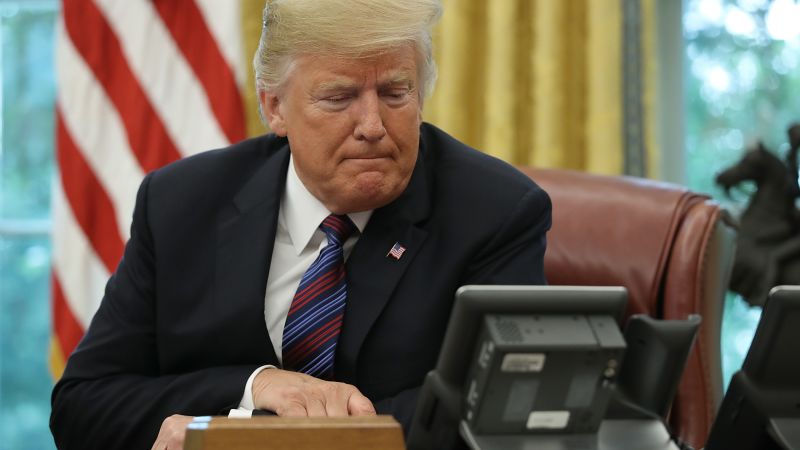Examining The Causes Of Trump's Aggressive Stance On European Trade

Table of Contents
Economic Factors Driving Trump's Trade Policy
Trump's trade actions against Europe were rooted in significant economic concerns, primarily focused on the persistent trade deficit and the perceived need to protect specific American industries.
The Trade Deficit with Europe
The United States consistently ran a substantial trade deficit with the European Union throughout the Trump administration. This imbalance, where imports from the EU exceeded exports to the EU, was frequently cited by Trump as evidence of unfair trade practices. The perceived negative impact on the American economy fueled his protectionist stance.
- Specific sectors with large trade imbalances: Significant deficits existed in sectors like automobiles, machinery, and pharmaceuticals. These imbalances were repeatedly highlighted by the Trump administration as justification for retaliatory tariffs.
- Impact on American manufacturing jobs: The administration argued that the trade deficit with Europe contributed to job losses in American manufacturing, particularly in industries competing with European imports. This narrative resonated strongly with Trump's base.
- The trade deficit as a political argument: The trade deficit became a powerful political tool, used to rally support for protectionist policies and to portray the EU as an economic adversary. This framing successfully resonated with segments of the American electorate.
Protecting American Industries
A central tenet of Trump's trade policy was the protection of specific American industries from what he deemed unfair European competition. This involved imposing tariffs on imported goods, aiming to level the playing field and boost domestic production.
- Examples of specific tariffs imposed on European goods: Notable examples include tariffs on steel and aluminum, impacting numerous European manufacturers. These tariffs often triggered retaliatory measures from the EU, escalating the trade conflict.
- The role of lobbying groups in influencing Trump's decisions: Powerful lobbying groups representing specific American industries played a significant role in shaping Trump's trade policy, advocating for protectionist measures to benefit their members.
- The impact on consumers in both the US and Europe: The tariffs imposed by the Trump administration led to increased prices for consumers in both the US and Europe, as goods became more expensive due to import duties.
Political Factors Influencing Trump's Approach
Beyond economic factors, political considerations played a crucial role in shaping Trump's aggressive stance on European trade.
"America First" Nationalism
Trump's "America First" ideology served as a foundational principle guiding his trade policy. This nationalist sentiment prioritized American interests above international cooperation and multilateral agreements.
- Examples of rhetoric used to justify protectionist measures: Trump frequently employed strong rhetoric, framing trade disputes as battles for American sovereignty and economic dominance.
- The impact on international alliances and agreements: Trump's "America First" approach strained relationships with traditional allies within the EU, undermining decades of transatlantic cooperation.
- The shift away from multilateralism towards bilateral deals: Trump actively pursued bilateral trade deals instead of multilateral agreements, reflecting his skepticism towards international institutions and his preference for direct negotiations.
Domestic Political Calculations
Trump strategically used trade policy as a tool to appeal to his political base and garner domestic support. Trade disputes served as a means to deflect criticism and garner attention.
- Evidence of Trump's trade policy influencing his approval ratings: While the impact is debated, some analysts suggest that Trump's trade policies, particularly initial actions, resonated positively with certain segments of his voter base.
- The role of media coverage in shaping public perception: Media coverage played a pivotal role in shaping public perception of Trump's trade policies, with both positive and negative narratives contributing to the overall discourse.
- The impact on the 2016 and 2020 elections: Trump's trade policies played a role in both his 2016 election victory and his 2020 campaign, highlighting the importance of economic anxieties in the American electorate.
Ideological Underpinnings of Trump's Trade Stance
Trump's trade policies were deeply rooted in his broader ideological beliefs regarding global trade and international institutions.
Rejection of Globalism
Trump expressed deep skepticism towards global trade agreements and international institutions, viewing them as unfair to the United States.
- Criticism of the World Trade Organization (WTO): Trump repeatedly criticized the WTO, arguing that it was biased against the United States and ineffective in addressing trade imbalances.
- Withdrawal from the Trans-Pacific Partnership (TPP): One of Trump's first actions was withdrawing from the TPP, a major multilateral trade agreement, demonstrating his rejection of global trade pacts.
- Negotiation of bilateral trade deals instead of multilateral agreements: Trump prioritized bilateral trade negotiations, believing that they offered greater leverage and allowed for more tailored agreements.
Bilateralism over Multilateralism
Trump consistently favored bilateral trade deals over multilateral agreements, a significant shift in US trade policy.
- Examples of bilateral trade negotiations initiated under Trump's administration: While some were initiated, few were finalized, highlighting the challenges of pursuing a purely bilateral approach.
- The advantages and disadvantages of bilateral versus multilateral approaches: Bilateral deals offer greater flexibility but can be more time-consuming and politically challenging to negotiate. Multilateral agreements, while more complex, generally provide greater stability and predictability.
- The long-term consequences for the global trading system: Trump's preference for bilateralism raised questions about the future of multilateral trade agreements and the role of international institutions in regulating global commerce.
Conclusion
Trump's aggressive stance on European trade was a complex phenomenon stemming from an intricate interplay of economic anxieties, political calculations, and deeply held ideological beliefs. The persistent trade deficit, the desire to protect American industries, and the "America First" ideology all fueled his protectionist policies. Understanding these interwoven factors is crucial for analyzing the broader implications of his presidency on US-EU relations and the global trading system. Further research into the long-term effects of these trade policies is essential to fully grasp their enduring impact. To delve deeper into this multifaceted issue, continue your research using relevant keywords like "Trump's trade war with Europe," "impact of Trump's tariffs on the EU," and "Trump's trade policy and global trade."

Featured Posts
-
 Jadwal Lengkap Moto Gp Inggris Di Silverstone Update Klasemen And Posisi Marquez
May 26, 2025
Jadwal Lengkap Moto Gp Inggris Di Silverstone Update Klasemen And Posisi Marquez
May 26, 2025 -
 Baffie Et Ardisson Une Querelle Explosive Analyse D Un Desaccord
May 26, 2025
Baffie Et Ardisson Une Querelle Explosive Analyse D Un Desaccord
May 26, 2025 -
 What Is A Flash Flood Understanding Flood Warnings And Alerts
May 26, 2025
What Is A Flash Flood Understanding Flood Warnings And Alerts
May 26, 2025 -
 Milan San Remo 2024 Van Der Poels Dominant Performance Secures Second Consecutive Win
May 26, 2025
Milan San Remo 2024 Van Der Poels Dominant Performance Secures Second Consecutive Win
May 26, 2025 -
 Unexpected Box Office Success A 2005 Romance Movies Second Act
May 26, 2025
Unexpected Box Office Success A 2005 Romance Movies Second Act
May 26, 2025
